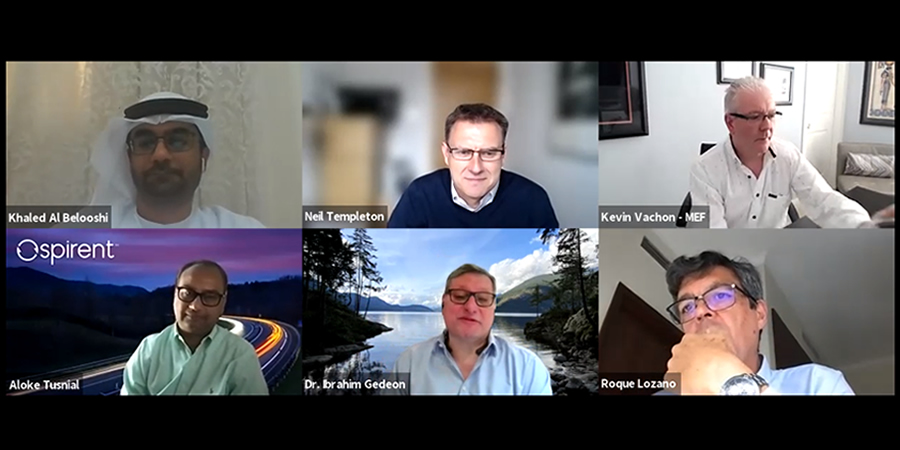Telecom Review organized a virtual panel on April 27, 2021, where a panel of industry experts discussed the topic of Network automation & SD-WAN in the era of virtualization. The esteemed panelists included:
- Mr. Roque Lozano, SVP IP & Optical Networks, MEA, Nokia
- Mr. Aloke Tusnial, Vice President, Cloud Business & Solutions, Spirent
- Mr. Khaled Al Belooshi, VP Fixed Networks, Etisalat
- Mr. Neil Templeton, Vice President, Digital Innovation Marketing, PCCW Global
- Dr. Ibrahim Gedeon, CTO, TELUS
The panel discussion was moderated by Mr. Kevin Vachon, Chief Operating Officer, MEF.
Following a brief welcome and thank you note by Mr. Toni Eid, founder, and CEO of Telecom Review, Kevin Vachon started the session by referring to a conversation that he had had with Roque Lozano earlier, where the latter had mentioned ‘automation as the forest and SD-WAN as one of the trees’ to illustrate the concept of the topic.
After a brief introduction by the panelists, the discussion moved towards first understanding the nuances of automation and gradually moving towards SD-WAN.
Considering that automation is a broad topic and a rather long haul when it comes to its implementation, the first question put to the panelists was ‘what are the major drivers for automation?’
Taking on the question, Khaled Al Belooshi felt that automation has become critical for operators. He said that it’s not optional anymore and instead has become more of a transformation process. “Automation along with network virtualization can bring clear value to the operators. It touches all stakeholders, whether it’s from HR, technology, and commercial, and needs to be handled with a clear strategy and standards for APIs and domains as a complete strategy,” he explained.
“When it comes to the drivers, I think there are two main drivers for automation -- it’s the digital experience that we want to bring to operators and the operational efficiency. Agility, a faster time, and rapid deployment are the things that we are looking for,” he said.
He also stressed the need to look at the new requirements for future networks such as mass customization of real-time and on-demand services from customers. “When it comes to operational efficiency, self-healing, self-optimization are areas we want to focus on with automation. Together with AI, we can actively address issues in the network before it causes outage problems,” he added. He also pointed out that the future network was going to be very complex with virtualization, network slicing, etc., and automation should play an important role in reducing this complexity.
Joining the conversation, Neil Templeton said that the automation journey at the service layer and application layer is only made possible by automation at the network layer. “The whole shift to the multi-cloud environment for business-critical applications, outside of traditional network parameter, needs flexible and agile network infrastructure.” He explained that for PCCW Global, the main driver for automation is the removal of complexity, taking out the friction and the cost. “You’ve got to automate as a necessity,” he added.
Adding flavor to the discussion with the security element to automation, Aloke Tusnial contributed by agreeing that automation was important from the self-healing perspective and removing complexity. But he said that the networks are getting complex by the day and by building configurations to remove complexity, the question of ensuring how the configurations work is critical.
“If something goes wrong, how do you troubleshoot?” he inquired. He also pointed out that networks are getting distributed and the multi-cloud environment is transitioning to multi-edge. “Earlier networks were centralized but now we are moving toward decentralization of network and security, which has become a big challenge,” he said. Touching on SD-WAN, he said the technology can add security at the edge as enterprises and customers are used to a certain level of security, and providing that same level of security should be the focus.
Dr. Ibrahim Gedeon reiterated that with the advancement of new technologies such as SD-WAN and other modernizations, customers expect frictionless automation. “People want to manage their own devices. Without automation, we won’t be able to compete with the expectations,” he stressed.
To wrap up the conversation over drivers of automation, Roque Lozano said that the cost and security were important when it comes to automation, but he felt the most important aspect was the business impact in ‘real-time.’
“The capability of doing more things, capability to rearrange network service in real-time are the key drivers as most operators know that new generation of services requires multi-services capabilities in the network,” he explained.
Another important point, he said was that we are not automating the network, we are automating the service to ensure that the whole value chain is automated. “The network for sure is the enabler, but the automation is not only regarding software and hardware that we install, automation covers the whole service proposition for the carriers and the enterprise,” he pointed out.
Touching upon the topic of SD-WAN, he said the technology will enable multi-application services. “SD-WAN is a particular application of technology that facilitates several use cases that are getting more traction in a couple of years,” he opined.










